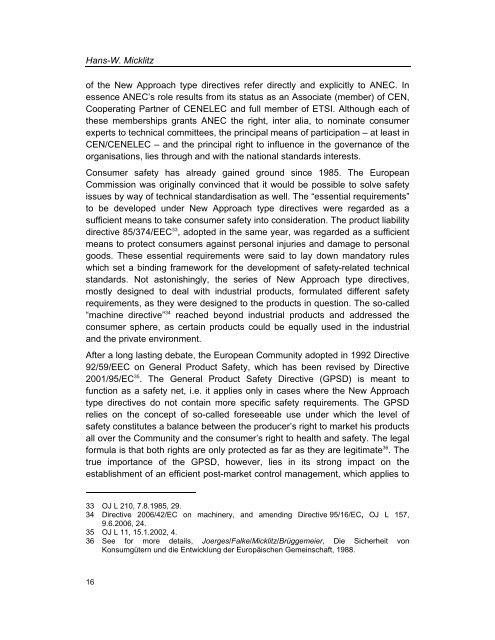Services Standards: Defining the Core Consumer Elements ... - ANEC
Services Standards: Defining the Core Consumer Elements ... - ANEC
Services Standards: Defining the Core Consumer Elements ... - ANEC
Create successful ePaper yourself
Turn your PDF publications into a flip-book with our unique Google optimized e-Paper software.
Hans-W. Micklitz<br />
of <strong>the</strong> New Approach type directives refer directly and explicitly to <strong>ANEC</strong>. In<br />
essence <strong>ANEC</strong>’s role results from its status as an Associate (member) of CEN,<br />
Cooperating Partner of CENELEC and full member of ETSI. Although each of<br />
<strong>the</strong>se memberships grants <strong>ANEC</strong> <strong>the</strong> right, inter alia, to nominate consumer<br />
experts to technical committees, <strong>the</strong> principal means of participation – at least in<br />
CEN/CENELEC – and <strong>the</strong> principal right to influence in <strong>the</strong> governance of <strong>the</strong><br />
organisations, lies through and with <strong>the</strong> national standards interests.<br />
<strong>Consumer</strong> safety has already gained ground since 1985. The European<br />
Commission was originally convinced that it would be possible to solve safety<br />
issues by way of technical standardisation as well. The “essential requirements”<br />
to be developed under New Approach type directives were regarded as a<br />
sufficient means to take consumer safety into consideration. The product liability<br />
directive 85/374/EEC 33 , adopted in <strong>the</strong> same year, was regarded as a sufficient<br />
means to protect consumers against personal injuries and damage to personal<br />
goods. These essential requirements were said to lay down mandatory rules<br />
which set a binding framework for <strong>the</strong> development of safety-related technical<br />
standards. Not astonishingly, <strong>the</strong> series of New Approach type directives,<br />
mostly designed to deal with industrial products, formulated different safety<br />
requirements, as <strong>the</strong>y were designed to <strong>the</strong> products in question. The so-called<br />
“machine directive” 34 reached beyond industrial products and addressed <strong>the</strong><br />
consumer sphere, as certain products could be equally used in <strong>the</strong> industrial<br />
and <strong>the</strong> private environment.<br />
After a long lasting debate, <strong>the</strong> European Community adopted in 1992 Directive<br />
92/59/EEC on General Product Safety, which has been revised by Directive<br />
2001/95/EC 35 . The General Product Safety Directive (GPSD) is meant to<br />
function as a safety net, i.e. it applies only in cases where <strong>the</strong> New Approach<br />
type directives do not contain more specific safety requirements. The GPSD<br />
relies on <strong>the</strong> concept of so-called foreseeable use under which <strong>the</strong> level of<br />
safety constitutes a balance between <strong>the</strong> producer’s right to market his products<br />
all over <strong>the</strong> Community and <strong>the</strong> consumer’s right to health and safety. The legal<br />
formula is that both rights are only protected as far as <strong>the</strong>y are legitimate 36 . The<br />
true importance of <strong>the</strong> GPSD, however, lies in its strong impact on <strong>the</strong><br />
establishment of an efficient post-market control management, which applies to<br />
33 OJ L 210, 7.8.1985, 29.<br />
34 Directive 2006/42/EC on machinery, and amending Directive 95/16/EC, OJ L 157,<br />
9.6.2006, 24.<br />
35 OJ L 11, 15.1.2002, 4.<br />
36 See for more details, Joerges/Falke/Micklitz/Brüggemeier, Die Sicherheit von<br />
Konsumgütern und die Entwicklung der Europäischen Gemeinschaft, 1988.<br />
16
















